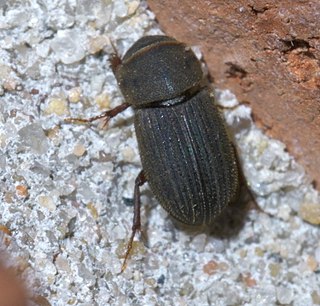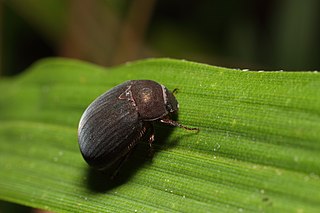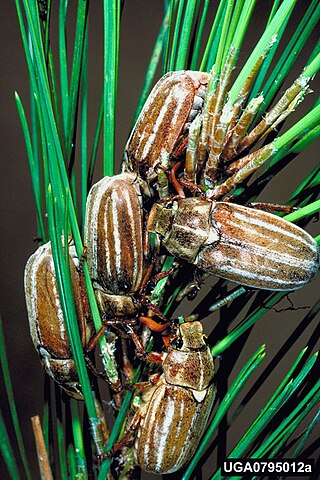
Ataenius is a genus of aphodiine dung beetles in the family Scarabaeidae. There are at least 290 described species in Ataenius.
Canthidium is a genus of dung beetles in the family Scarabaeidae. There are at least 170 described species in Canthidium.

Hoplia is a genus of monkey beetles in the family Scarabaeidae. There are at least 300 described species in Hoplia. These species are found in Asia, Europe, South Africa, Madagascar, and the Americas.

Onthophagus nigriventris is a species of dung beetle in the family Scarabaeidae.
Xeropsamobeus asellus is a species of aphodiine dung beetle in the family Scarabaeidae. It is found in the United States and Mexico, although other sources consider it endemic to Texas.

Geotrupinae is a subfamily of earth-boring scarab beetles in the family Geotrupidae. There are more than 30 genera and 450 described species in Geotrupinae.

Phanaeini is a tribe of dung beetles in the family Scarabaeidae. There are about 12 genera and 200 described species in Phanaeini. They are native to the Americas with the highest species richness in the Neotropics. They are mostly coprophagous or necrophagous, but some of the least known genera appear to be myrmecophilous. They are medium-sized to large beetles, often with bright metallic colors, and often with horns on their heads.
Onthophagus coproides is a species of dung beetle in the family Scarabaeidae.
Selviria is a genus of aphodiine dung beetles in the family Scarabaeidae. There are at least two described species in Selviria, both found in Brazil. Selviria matogrossoensis has been reported in a nest of fire ants.
Hoplia sackenii is a species of May beetle or junebug in the family Scarabaeidae. It is found in North America.
Dichelonychini is a tribe of beetles, known as May beetles and Junebugs, in the family Scarabaeidae. There are at least 3 genera and 60 described species in Dichelonychini.
Aegialia cartwrighti is a species of aphodiine dung beetle in the family Scarabaeidae. It is found in North America.

Maladera japonica is a species of scarab beetle in the family Scarabaeidae.
Haroldiataenius is a genus of aphodiine dung beetles in the family Scarabaeidae. There are about nine described species in Haroldiataenius.
Hypotrichia is a genus of May beetles and junebugs in the family Scarabaeidae. There is at least one described species in Hypotrichia, H. spissipes.

Polyphylla occidentalis is a species of scarab beetle in the family Scarabaeidae. It is found in North America.
Aidophus is a genus of aphodiinae dung beetles in the family Scarabaeidae. There are about 12 described species in Aidophus.
Parataenius is a genus of aphodiine dung beetles in the family Scarabaeidae. There are about six described species in Parataenius.
Podolasiini is a tribe of May beetles and junebugs in the family Scarabaeidae. There are at least 2 genera and about 18 described species in Podolasiini.
Phyllophaga forsteri is a species of scarab beetle in the family Scarabaeidae. It is found in North America.







